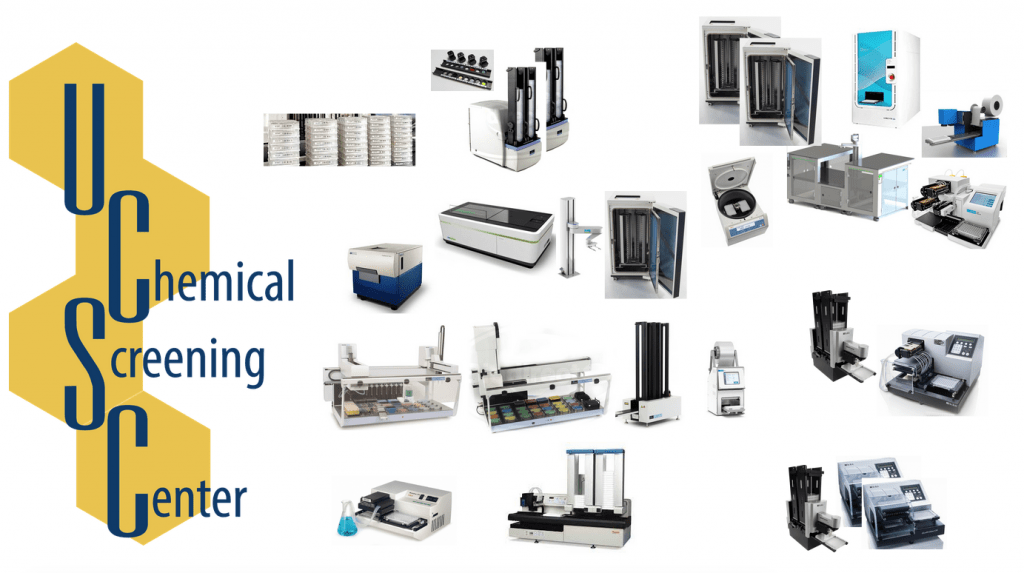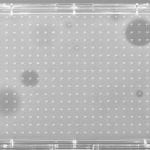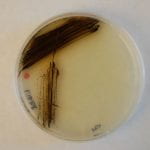For a list with the current operating status of each piece of equipment, that is updated ~quarterly and includes any scheduled repairs and any recent changes to operating practices, please go here.
List of equipment currently available to trained users:
- Perkin Elmer Explorer G3 workstation for sample prep, controlled by PlateWorks software, with a Flex swivel arm transferring samples between the following equipment:
- Two Perkin Elmer EnVision plate readers with ultrasensitive dedicated luminescence PMT and stacker
- HTS dual reader with alpha screen laser, time-resolved fluorescence, and internal heating
- Xcite plate reader
- Two high throughput high content imagers
- Perkin Elmer Opera Phenix Plus spinning disc confocal with 2 cameras, 4 lasers, 13 emission filters, and internal environmental control. When controlled by PlateWorks software, the Phenix can interface with a Flex swivel arm transferring samples between the room temp plate hotel or LiCONIC incubator. Plates can be moved here as an entire removable rack compatible with the Explorer workstation incubators.
- Molecular Devices Image Xpress Micro imager with 4 channels
- Three pipetting robots
- Perkin Elmer Janus MDT with 96-channel P200 head, 3 pin tools, pin cleaning hardware, plate stacker, and barcode reader
- Perkin Elmer Janus Varispan with 8 individually controllable pipetting heads, under a chemical fume hood
- Eppendorf epMotion with a one-channel head, inside an enclosure for sterile conditions
- 6 bulk liquid handling instruments
- BioTek EL406 with peri/syringe/wash modules and a BioStack4, all operated with LHC software
- BioTek ELx405 with BioStack
- BioTek ELx405 stand-alone unit
- BioTek MultiFlo
- Thermo Multidrop 384
- Matrix Wellmate which has a built-in stacker
- Other equipment: PlateLoc thermal sealer, automated desiccator, 4 freezers, 2 refrigerators, vortexer, mini microcentrifuge, Pipet Aid, Pipetmen
- Image analysis and bioinformatics software including Signals Image Artist, Spotfire, Harmony, and Image Xpress on user workstations
- 9 instrument controller PCs, 5 PCs for users to access for data analysis, and 3 office Macs. The Signals computer has a RAID5 data storage system. The space currently has 1GB networking.
- Uninterruptible power supplies for most equipment and computers, including the Explorer/Echo workstation, backed up by generator power.
*This page is under construction*
*please come back for the final version*
Laboratory
UCSC Chemical Screening Center: The CSC is a core facility (RRID SCR_021114) serving the research community at UCSC and beyond, supported by the California Institute for Quantitative Biosciences and the UCSC Physiological and Biological Sciences Division.
The CSC has a total of ___sq. ft. of laboratory space on the fourth floor of the recently constructed (2006) Physical Sciences Building (PSB). The lab space includes 2 6-ft fume hoods, house utilities (deionized water, air, vacuum), ___ linear ft. of open bench space plus ___ linear ft. of bench space with table-t0p instrumentation, shelving, and an adjacent space for supplies storage (___sq. ft.). Other labs on the same floor provide us with a tissue culture room, ice machine, and autoclave, and within our building we have flammable storage cabinets (in a room specifically designed for flammables storage), liquid nitrogen, dry ice, access to a balance and pH station, and a cold room. Our building also houses the mass spectrometry facility, NMR facility, X-ray crystallography facility, and macromolecular structure and function facility, and adjacent buildings house the microscopy facility and flow cytometry facility.
The center is supervised by Scott Lokey, Professor of Chemistry, and managed by Beverley Rabbitts, a PhD-level scientist who assists with project design, protocol development, sample preparation, instrument training, and data interpretation. Shared instruments are available to trained users 24/7 on a recharge fee per hour of use basis.
The facility houses a compound collection that includes 8,000 known bioactives from TargetMol; 2,000 known bioactives from SelleckChem; 87,000 drug-like diversity compounds from ChemDiv; 1,262 low molecular weight fragment compounds from Kevin Gardner and Life Chemicals, 400 cyclic peptides from the lab of Scott Lokey, and a growing collection of marine and terrestrial natural products from the labs of Phil Crews, John MacMillan, Roger Linington (now at Simon Fraser University), and others. Compounds are typically provided as 10mM or 10mg/ml stocks in DMSO in 384-well daughter microplates with minimal number of freeze-thaw cycles.
High throughput screening (HTS) robotics are used to test up to 50,000 compounds per day to identify biologically active compounds targeted towards a variety of biological systems, with legacy data available for comparison. The CSC houses an Echo 650 acoustic dispenser at a robotic sample-preparation workstation, two high throughput imagers including a robot-automated Opera Phenix Plus confocal, two EnVision plate readers, three pipetting robots, 6 bulk liquid handling instruments, image analysis and bioinformatics tools and software, and more (see equipment list for details).
Office
The Chemical Screening Center has ___ sq. ft. office (PSB456) on the same floor near the CSC wetlab (PSB465). This office has desk space for 3 researchers, including one shared user workstation, a desk for the CSC manager, and a desk for research staff working in the CSC. In addition to lab benches, the CSC wetlab has two desks for data analysis work. Administrative support is available through the Department of Chemistry and Biochemistry.
Computer
The Chemical Screening Center has … (in progress!)
Other resources
Please click on the accordion buttons below, to expand the items you want to view.
- For viewing images/compounds/etc. of CP data: CP-ImageView App
- For looking at a list of immunoCP run contents: immuno-CP contents
- For viewing heatmaps of plate reader scans, with associated chemical structures, we previously developed Halo384 Compare. This is no longer publicly available at the old link – please contact us for access.
Go here for UCSF Pharmacy microsites, which includes:
Looking for the Pipeline Pilot WebPort? Please email us for more information.
COMING SOON: Signals software for quantitation and statistical analysis of high throughput screen image data. Includes deep learning algorithms to identify cell phenotypes.
Users can access several PC options for data analysis, such as with MetaXpress image analysis software packages, FileZilla for server uploads, and TeamViewer remote control (please enquire to get the ID and password of the one(s) you need). The image data server is housed by a PC located in the lab, next to the imaging computer. Three analysis computers located in the CSC office space are networked and able to process batch jobs together for faster computing.
We have two dongles for MetaXpress image analysis software, with five seats. The package purchased including image segmentation, multiwavelength scoring of cell objects, and automated batch processing. We have curated custom modules, or journals, designed for high throughput, high content phenotype fingerprinting in cytological profiling experiments.
Furthermore, we have developed several in-house tools that can be accessed on our "links" page (also on the menu bar above).
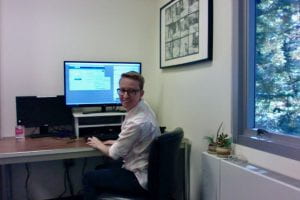
Owned by the MacMillan lab and assisted by the Chemical Screening Center, this facility has a biosafety cabinet, humidified CO2 incubators, brightfield microscope, water bath, and Thermo Locator liquid nitrogen cryo-storage for mammalian cell lines. It is conveniently located on the same floor as the CSC, just two doors down the hallway. Small instruments, such as the MultiDrop, can be carried from the CSC and placed in the hood, as desired.
A variety of 6, 12, 24, 48, 96, 384. and 1536 format multiwell microplate types are available approximately at cost.
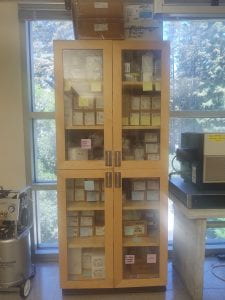
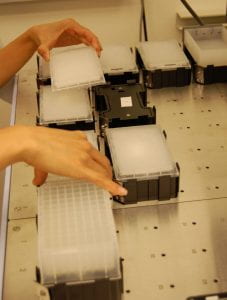
Select what is most appropriate for your particular assay…
- plastic colors:
- white plates for luminescence on the plate reader with top read
- black plates for fluorescence on the plate reader with top read
- clear bottom, black plates for inverted fluorescence microscopy
- clear plates for absorbance
- clear UV-compatible plates for absorbance at short wavelengths
- whitish plastic is the most economical and is free of chemical residues left by plastic clearing treatments (e.g. use for compound storage)
- untreated plastic or tissue culture-treated, with or without poly amino acid (e.g. poly-lysine), collagen, or other coatings
- sterile (e.g. for if growing cells in the plate) or not (for short timecourse endpoint assays and toxic reagent storage)
- vented or low-evaporation lids – or without lids (leaving lids out is faster! Plate #1 in the stack serves as the lid for plate #2, and so on)
- well shapes:
- flat bottom (optimal for endpoint measurements and adherent cells)
- V bottom (optimal for compound stock plates of small volume)
- U bottom (optimal for even mixing)
- skirt heights
- non-skirted for fitting inside PCR machines and other temperature-controlled blocks
- full-skirted are the most durable
- half-skirted are better for high magnification imaging (reduce the working distance needed by the objective at the edge wells)
- regular depth, small volume reduced depth, or deep well
- several brands available for each, with slightly different specifications
We also have various types of universal lids and reservoirs for multichannel pipettes.
Please enquire about the plate type you desire, so we can check our inventory and set aside plates for you.
Please be aware of the exact plate product number used, so that appropriate settings can be entered into instruments handling those plates.
We employ full-time expert staff to train and assist you.
- The CSC personnel keep up to date in the fields of high throughput biology, drug discovery, and laboratory automation, and use this knowledge to make strategic choices in acquisitions and upgrades, as well as to make application-specific recommendations to improve your workflows. This partners very nicely with laboratories focused on research questions, rather than technology.
- We painstakingly maintain the fleet of equipment to ensure continuing, reliable resources as much as possible. This includes calibrating and quality control, preventative maintenance, and coordinating repairs. We are intimately knowledgeable on the specific devices housed here, and thus we can help problem solve if issues arise during experiments. In these ways, we are able to provide technologies that would be prohibitively complex to be housed in a lab without staff dedicated to instrument management.
- The resources are made possible by a combination of fees we collect from users, funds from the UCSC Office of Research, NIH and other instrumentation grants, and from philanthropic donors – we are therefore able to provide technology that would be prohibitively expensive to obtain and maintain by an individual lab – technology that is essential to drive modern research forward effectively and competitively.
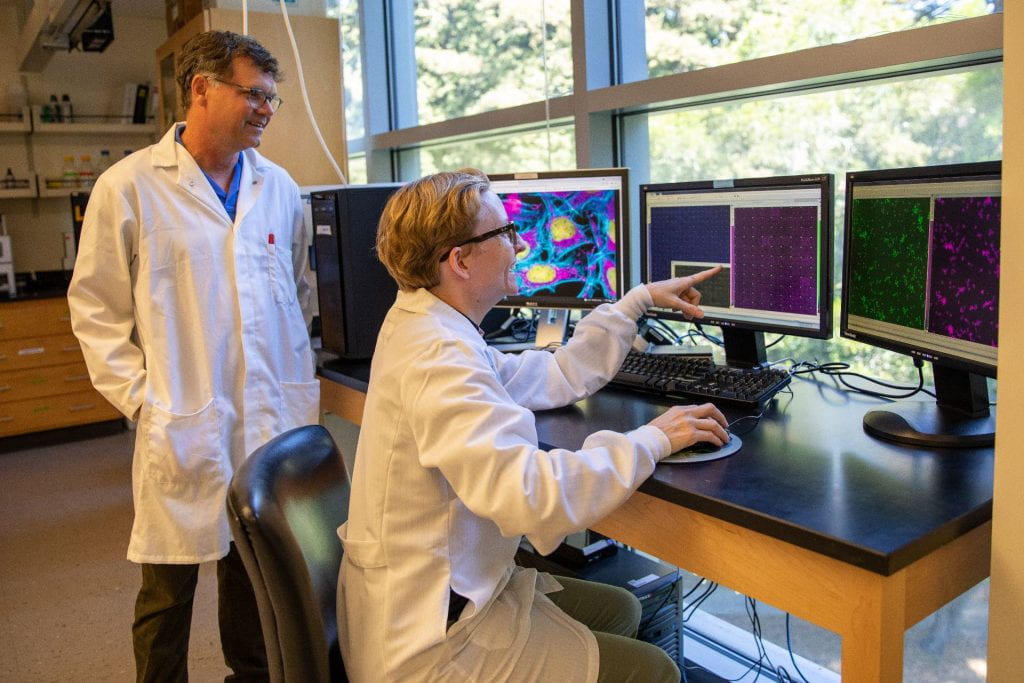
Compare your dataset from unidentified or novel compounds with data collected by the CSC using known bioactives for guilt-by-association mechanistic insights. We have data collected from a variety of common assays, including cytological profiling and cytotoxicity experiments.
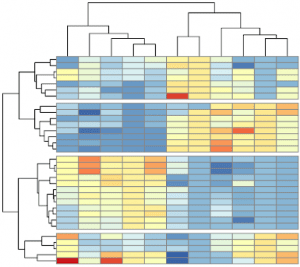
(image from r-bloggers.com)
For high throughput applications, barcodes help reduce human error in sample management. We have a barcode printer, and the printed sticker labels can be manually affixed to your plates, and read by several of our instruments that have onboard barcode reading capability. Alternately, pre-barcoded plates can be purchased, for use on those instruments without the need for printing and sticking labels.
We have established collaborations with numerous esteemed researchers on our campus and beyond.
In 2021, we helped form a cooperative network between core facilities at UCSC. We are proud to be part of the team of core facilities bringing you a range of key resources such as: NMR, cryoEM, crystallography, flow cytometry, light microscopy, scanning electron microscopy, genomics, transgenics, vivarium, optofluidics, isotopes, cell browser, paleogenomics, marine analytics, plasma analytics, COVID testing, a clean room, etc.
- Plate map templates (graphical format)
- Spreadsheet for interconverting between list format and plate format!
- Buffer recipes: PBS, PBS+azide, Tris
- Autoclave protocol (autoclaves in PSB 2nd and 4th floors, only 2nd floor is for biohazard)
- Cell culture: ICLAC curates a Register of cell lines that are known to be misidentified through cross-contamination or other mechanisms (e.g., mislabeling). We suggest that you check for your cell line in this database. We suggest that you perform mycoplasma contamination testing on your cell lines and other verification, as needed. These actions are suggested, and sometimes required, by top journals.
- A handy cell culture media selection tool from Gibco
- Bacteria: a database of media recipes published here and available at an interactive website.
- CSC new employee onboarding
- FACES manual
- Gen5 software guide (120 pages PDF)
- Introductory slides I’ve used before when giving a lightning talk about the CSC are here (and an older version with additional CP slides here).
